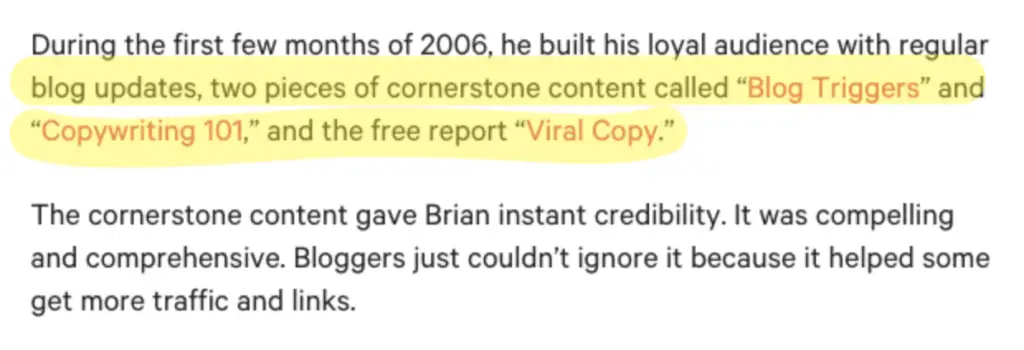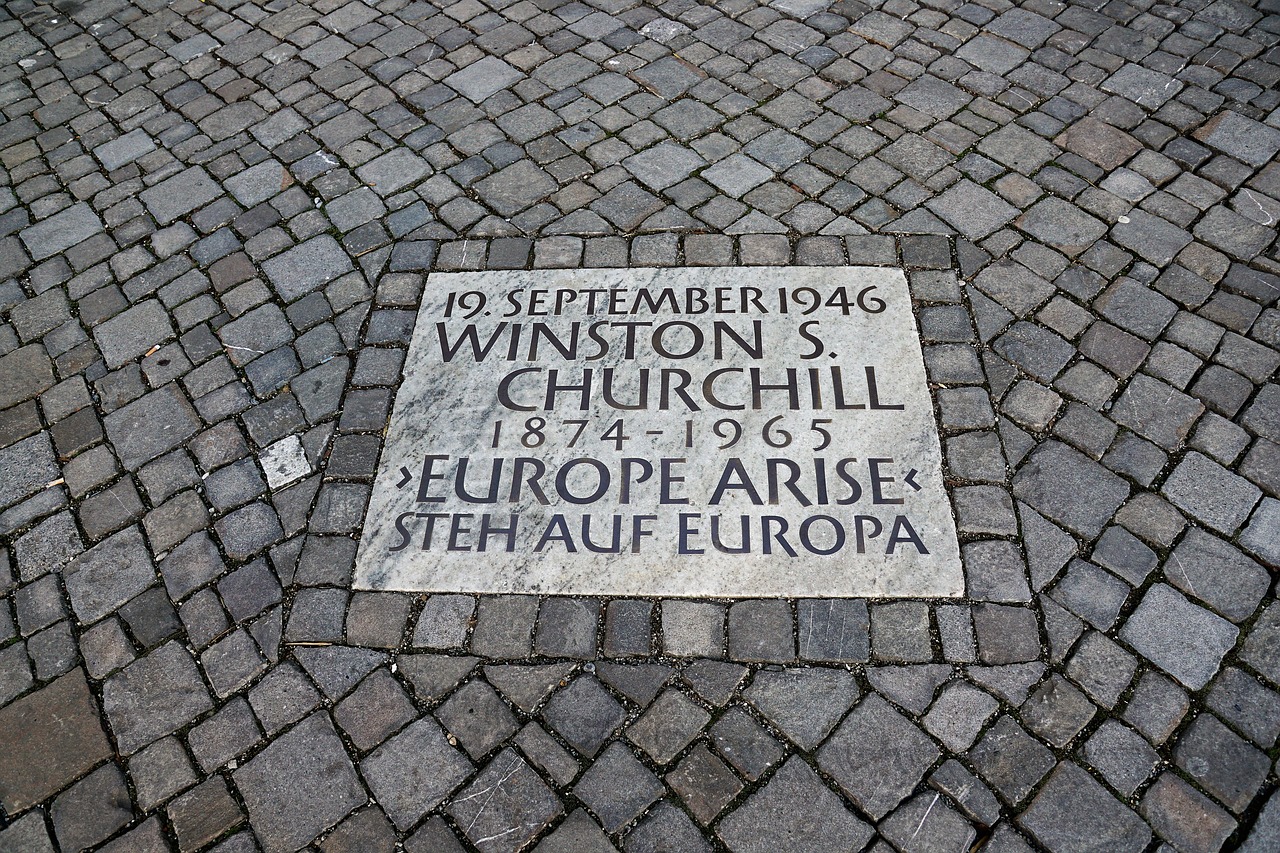Cornerstone content sounds fancy at first, but it’s actually a rock-solid thing. Because cornerstone means nothing more than “foundation stone”. Cornerstone content is the foundation of your website, so to speak, what I like to call the “content home”.
In order for your website visitors to feel comfortable in your content home and stay there for a while, it should be tidy and have a certain order. After all, who likes digging through chaos? Especially when there is so much free content out there. Right, nobody.
Neither does Google. Google loves structure. The Google bot reads website content by following links. If your content doesn’t have a meaningful structure, it won’t improve your site’s search engine rankings.
Cornerstone content importance example
Imagine that a Medium reader refers you to a new website on a topic that interests you.
Let’s say this site is about creating a new blog or something you’ve been looking for for a while.
So you used the link in the article, landed on the blog section of the new site, and read about something useful. You are interested in learning more. But you couldn’t find a way. There was no roadmap to guide you. The website menu had the default options and nothing more.
If this website only had a dedicated page that takes you to the most important sections, wouldn’t you have liked it more?
Perhaps the same site even had a subscription form that allowed you to subscribe to all updates from that site.
Well, this dedicated page is called cornerstone content page and all the content is the cornerstone of the blog.
Sites with a dedicated cornerstone content page ensure that their new visitors don’t feel lost and can access the site’s most important content through a single piece of content that is easily accessible through their home page.
Cornerstone Content, Cornerstone Content Pieces, and a Cornerstone Content Page
Cornerstone content is a compilation of the most important content on your blog.
The unmissable content of your blog can be one of the most read, shared and relevant posts. Such posts are cornerstones of content that you link to from your cornerstone page.
A cornerstone content page is a simple page on your site that lists all of your cornerstone content items.
Importance of the cornerstone content
In Brian Clark’s words,
“A cornerstone is…fundamental, essential, indispensable, and the primary foundation upon which something is built or developed. It’s what people need to know in order to use your website and do business with you.”
What does this mean for your website?
Your cornerstone is like the glossary page of your website.
Here’s a video that goes into more detail:
Many new visitors to your site can only understand your site if they are directed to this glossary page, or at least if it is accessible to them.
Your regular readers or people who already do business with you may not need it as much because they know what your site is about and they also know how to use it. However, new visitors may need a compass on your site to guide them along the way. This compass is your cornerstone.
Here’s an example. If you look through the Copyblogger library today, you’ll find about 15 cornerstones. All of these pieces (available in the form of free e-books) represent some of Copyblogger’s best content. They’re all about content marketing – and that’s what Copyblogger is all about!
Here’s what Brian Clark writes:

So it is clear:
Cornerstone content links to and directs your readers to the most important and relevant content on your website.
What are the different types of cornerstone content?
You can use all kinds of content types as cornerstones for content:
- An e-book or an entire library
- A simple PDF
- A series of podcasts
- A series of videos
- A compilation of your best and most strategic content

For example, Neil Patel offers some valuable guides on his personal blog. They deal with online marketing, SEO and content marketing, among other things.
If you look at the topics of the guides, you will see that they are directly associated with his company.
This is a key feature of a cornerstone, i.e. it is highly relevant.
Tip: Don’t confuse cornerstone content with freebies (or lead magnets) or incentives used to build email lists.
2 simple approaches to writing a cornerstone content page
For websites with a lot of content
If you’ve studied your audience and done some keyword research, you may have already covered some of the most important content on your blog.
Now you can find them using the site search function, compile a list of 8-10 great posts, and put together a page (your cornerstone page) that lists them all.
To use the site search feature, type your site’s URL into Google and add a “:” followed by your seed keyword.
Syntax: yourwebsite.com: start keyword
For example, if I were to create a cornerstone page for MakeAWebsiteHub, I would simply go to Google and type:
makeawebsitehub.com:WordPress
Google will pull all the results it thought were relevant for the keyword “WordPress” on MakeAWebsiteHub.
Like these guides to:
- Speed up WordPress
- WordPress securityWordPress hosting
So I would just compile a list of all these post titles, add little descriptions and link to them. And my cornerstone content page would be complete!
For brand new websites
Since there is very little content on a new website, it is not expected that all posts can be linked from your cornerstone page.
However, list any potential topics you will cover and update your cornerstone page with links to those topics as you write. By listing all potential topics on your cornerstone page, you ensure that you actually cover them.
Here’s a process you can use to create a cornerstone page for a new website.
First, make a list of the keywords you want to target. You need keywords to place them in all relevant places on your cornerstone page.
For example, if you want to create a blog about online marketing, you should first work out some initial keywords.
For that first brainstorming session, I recommend going straight to Ubersuggest. It’s a tool that uses Google’s autocomplete suggestions to give you lots of potential keywords. Just enter your seed keyword (“online marketing” in this example) and click Suggest.
Ubersuggest then suggests a set of long-tail keywords.
In my example, I found a few particularly helpful:
- best (free) online marketing tools
- Online Marketing for (Appeal to) Millennials
- Online Marketing (Tips To Get) Traffic
- [X] Online Marketing Tips for Small Businesses
- Online Marketing Terminology [all jargon explained]
- Online Marketing Templates [To Plan the Perfect Digital Marketing Campaign]
If you noticed, I used the potential keywords and came up with a few tentative post titles.
In fact, if you’re doing this exercise for your website, you should create all of these posts because your target audience is looking for them. Once you have all of these posts ready, you will be linking back to them from your cornerstone content page.
You should aim for around 8-10 such keywords.
You can also use a tool like SEMRush to find more keyword ideas.
You may not have covered any of these topics. Add them to your cornerstone page anyway, as you may want to cover them.
For keywords that haven’t been covered yet, you can simply add text like “This post is in progress. Subscribe to my blog to be the first to know.”
In either case (established sites or new sites), update your cornerstone page if you’re writing a piece that will become popular with your blog readers.
Since all of the posts that make it to your cornerstone are closely related, find ways to tie them together.
A quick 5-step process to create your cornerstone page
Step 1 . Create a new page on your website and name it “Cornerstone Content Page” for now.
Step 2 . Link to this page from your main menu (you could call it something like “Start Here”).
Step 3 . Write content for your cornerstone page
- An introduction of 150 to 200 words
- A short description for each link you share on the page (about 200 words total for this section)
- A conclusion in 100 words
- Call to action copy
As you can see, an important cornerstone page can be more than 1000 words.
Step 4. Add a CTA
Now that you have some decent cornerstone content, it’s time to think about what you want the people reading your cornerstone content to do.
For example, you may want them to:
- Subscribe to your blog
- Register for your online course
- Download a giveaway
Once you’ve decided what you want your readers to do, add your CTA to your cornerstone page.
Notice: Your goal is to create a helpful page, rather than a “cute” or “fancy” page.
Step 5. Publish.
Your super helpful cornerstone site is now live!
Navigating to your cornerstone content
Once you’ve created a great cornerstone content page, you need to link to it from your home page.
Yoast recommends:
Cornerstone articles should appear very high in your site’s pyramid. Ideally, your cornerstone page will be instantly clickable from your home page.
As I said at the beginning, a good cornerstone site acts as a compass for a new visitor. It links the visitor to the most important sections of a website.
Using the cornerstone page to get backlinks, leads, and social shares
The job of your cornerstone content page is to help new visitors navigate your site.
But you can also get more traction for your website by:
- Get backlinks: Because a cornerstone content page is so rich in relevant content, it attracts a lot of backlinks.
- By using your cornerstone content page for outreach activities like guest posting, you can improve your website’s SEO. With lots of quality backlinks, your cornerstone site’s authority and rankings in search engine results will increase.
- Social shares: When users value your resource a lot, they are more likely to share it with their social followers.
- By keeping social sharing icons handy on a cornerstone content page, you can amplify your social signals.
- It is known that social signals are part of the Google ranking algorithm. So make it easy for your visitors to share your cornerstone content page.
- Leads: By promoting your cornerstone content, you can make it one of the liveliest areas of your website – one that attracts lots of quality leads.
Conclusion
Now that you know the ingredients that make helpful cornerstones and a page, create one for your website today.
Have questions about creating a cornerstone page? Or do you need help validating ideas for your cornerstones?

